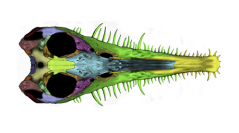

 Comptes Rendus Palevol
11 (5) - Pages 379-391
Comptes Rendus Palevol
11 (5) - Pages 379-391The Early Permian mesosaurids are the oldest known aquatic amniotes with an exclusively Gondwanan distribution. Although several hundred of complete skeletons have been discovered and intensively studied, the anatomy and taxonomic composition of the group, as well as its phylogenetic relationships remain controversial. Several well-preserved mesosaurid specimens found in Uruguay justify a new anatomical reconstruction of the skull of Mesosaurus tenuidens, differing from earlier ones especially in the presence of a lower temporal fenestra. The significance of this structure for the evolution of temporal fenestration in amniotes is evaluated according to the two most recent phylogenetic hypotheses, in which mesosaurids are basalmost sauropsids or basalmost parareptiles. A synapsid-like fenestration may be the primitive condition for Amniota, and it may be also a basal condition for parareptiles, because recent phylogenies suggest a basal position for mesosaurids and lanthanosuchoids within that group, and both possess a lower temporal fenestra. Our results also give a moderately strengthened support for diapsid affinities of turtles.
Mesosauridae, Early Permian, Gondwana, Skull anatomy, Temporal fenestration, Taphonomy, Amniotes